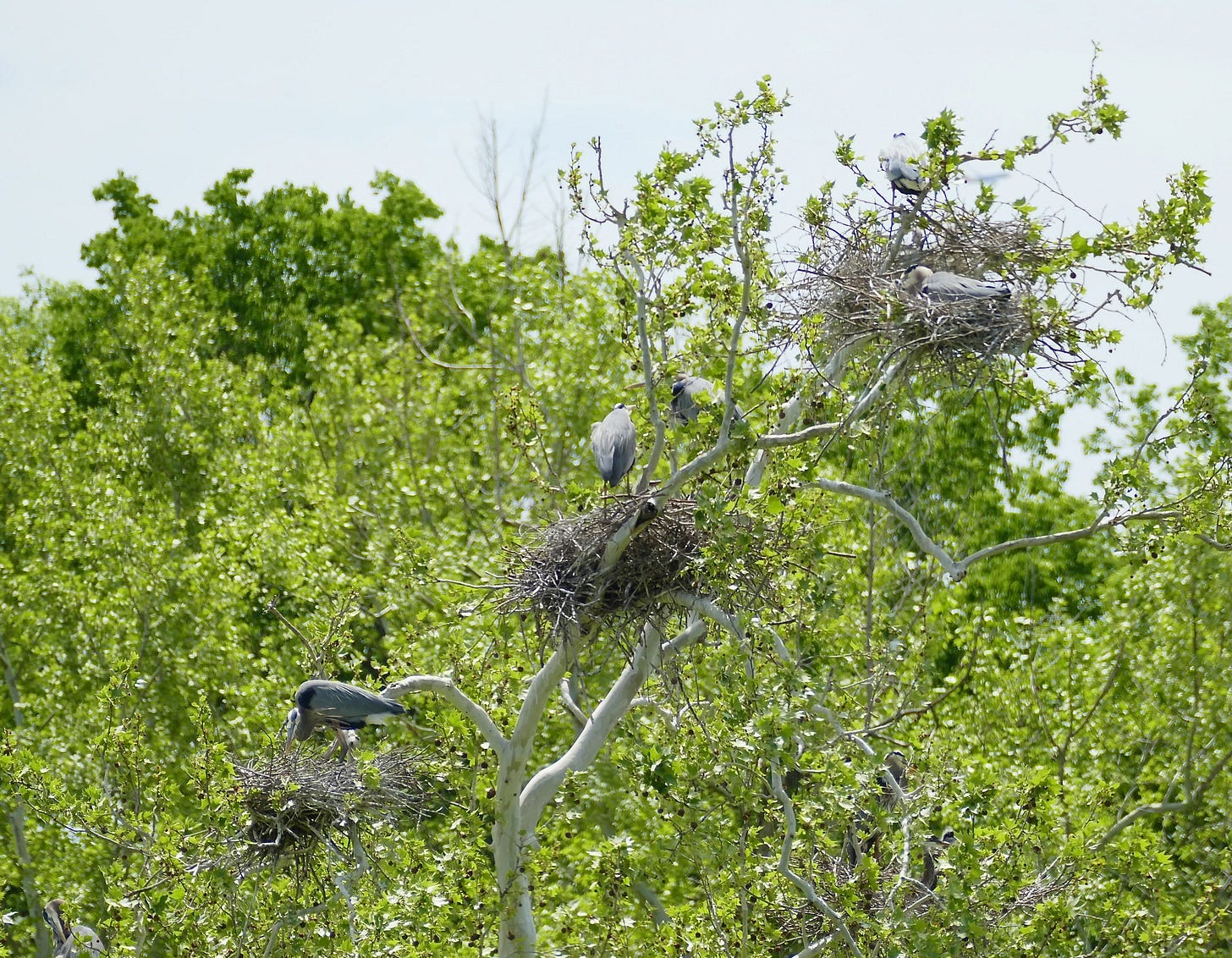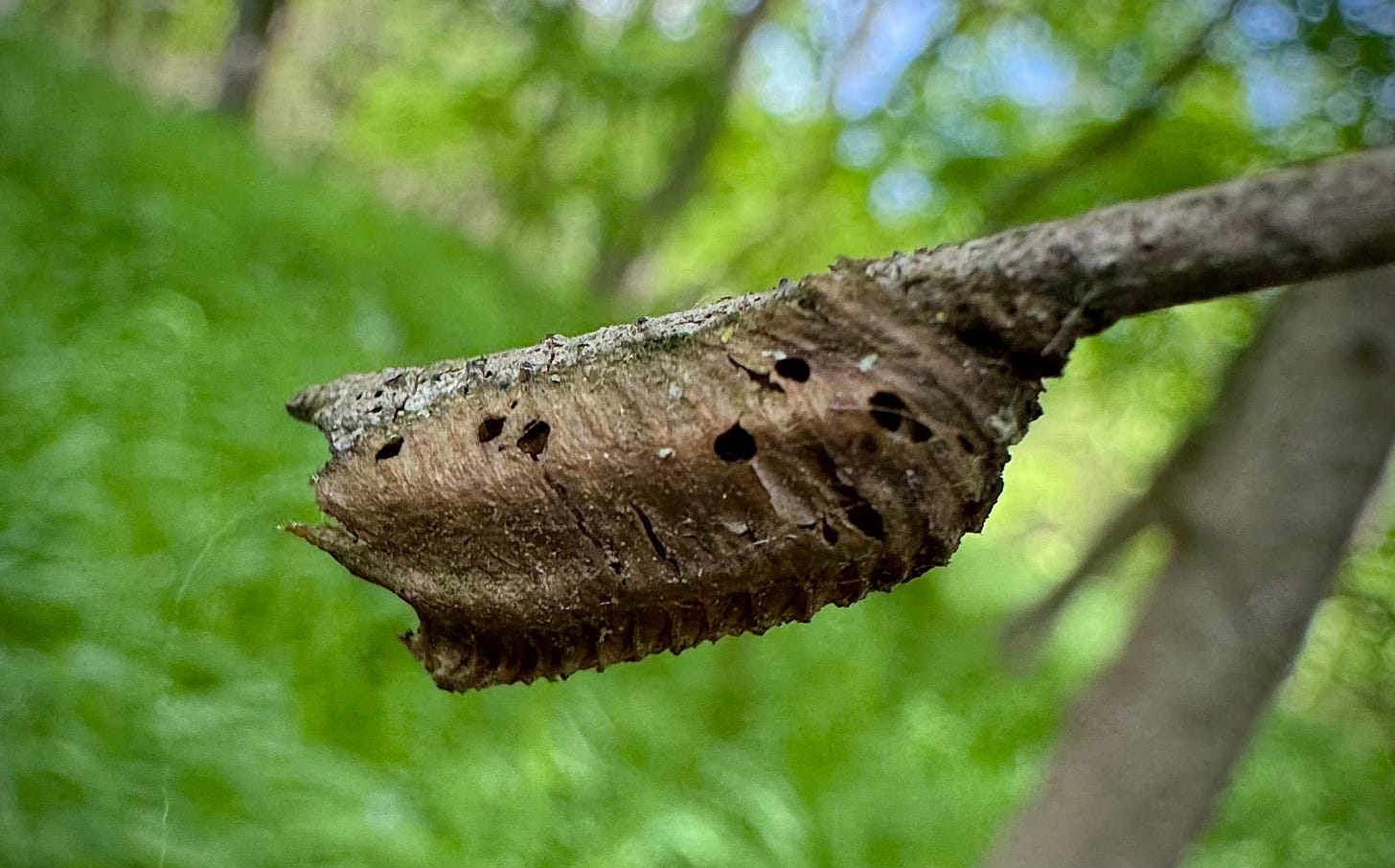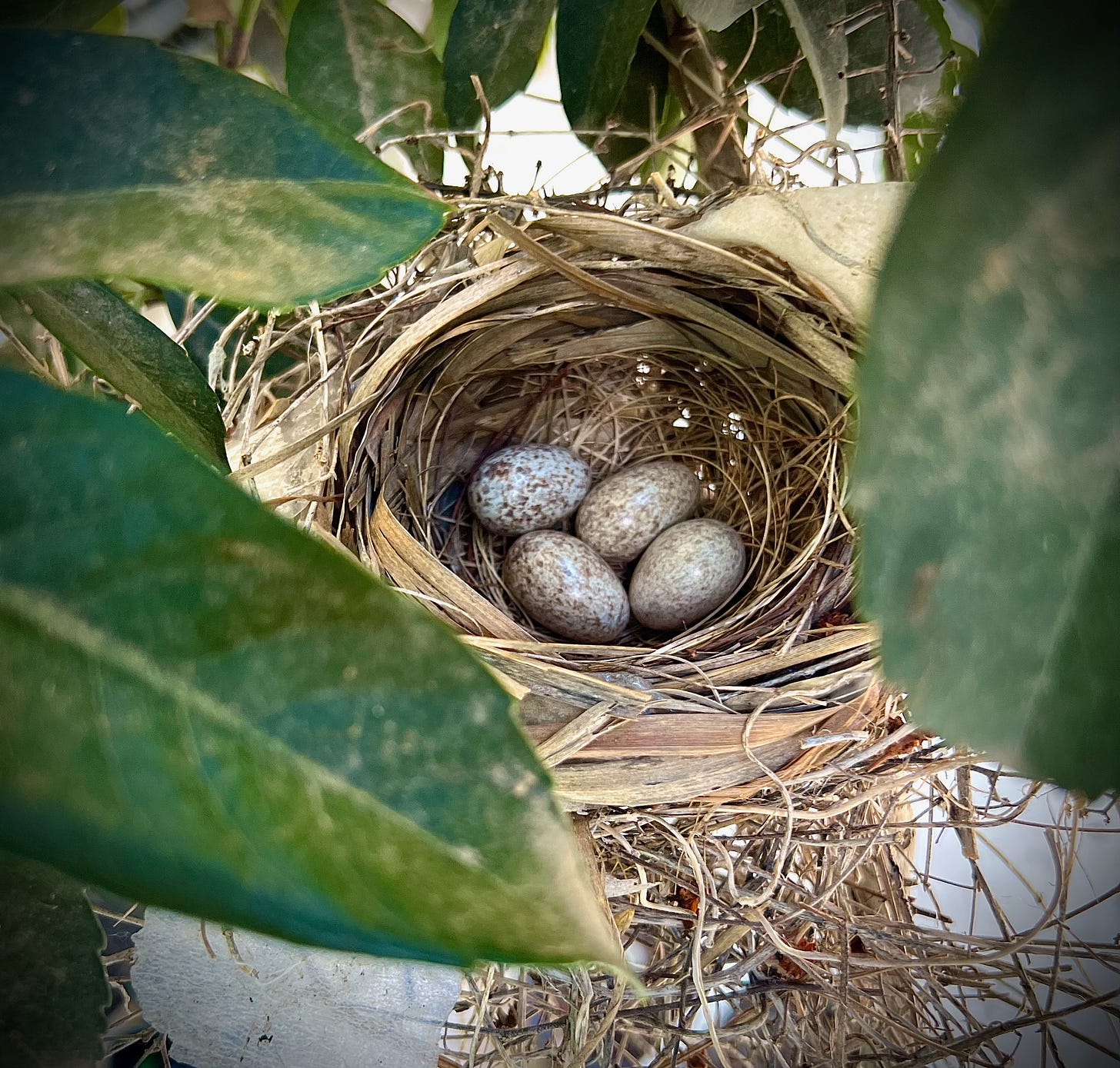Nest builders of the Worm Moon
No. 150
The first quarter-mile out of our front gate is always a little hazardous for a jogger, as we live half a block from a spot where traffic from two major highways connects with the main roads coming east from downtown. A convergence of concrete loops, hurtling trucks, and people anxious to get to work. Not a landscape where you would think wild nature is steps away. Until you learn that, on a planetary surface that now has more human-made material than natural biomass, it’s often in the most casually brutalist pockets of the world we engineered that other life makes its home. As I was reminded Monday morning, running in the rain, when I came upon the first burst of native wildflowers blooming in the berm. Indian paintbrush, coreopsis, beeblossom and bluebonnets, holding out in a spot that was terraformed by big machines five short years ago when they remade the highway into a high-speed toll road.
When I got to the old bridge, which is now used exclusively by bikes, foot traffic, and neighborhood graffiti artists, an osprey was circling close by, in the kind of stalking flight that sometimes suddenly turns into a dramatic dive. I stopped and watched for that, and then looked down to the river below, where it winds its way from the last dam. A group of eight cormorants were paddling upriver, in a spot where the channel deepens after a wide shallow bend. The osprey seemed to be tracking over them, waiting for their goofier predatory energy to stir up the big fish. You could almost forget that if you looked the other direction, you would be confronted with the underside of eight elevated lanes of tollway, and the next plane about to land at the nearby airport.
Look up in the early morning here and you might see a different kind of traffic, as the seasonal migrants begin to arrive. I started hearing the black-bellied whistling ducks at the beginning of March, in the dark just before dawn, but it wasn’t until last Sunday, walking our old dog and young daughter down these weird streets, that we saw a pair in the mid-morning light, perched on the power line where it threads through the trees behind the motor oil distribution yard.
The ornithological authorities call Dendrocygna autumnalis a “boisterous duck.” They are big, with long thick legs, and when they move around in those urban trees their kinetic energy has a paradoxically gawky grace. Their preferred nesting sites are tree hollows, and when you see how big the seasonal flocks are, and how big the individual ducks are, you might wonder just where it is they are finding places to live and breed in the city.
A block away, behind the chain link that secures an empty concrete pad where they aim to build a boutique hotel perched over the urban river, the great blue herons are busy in their rookery at the top of a tall white sycamore that grows from an island made of landfill trash, riparian sediment, and aquatic vegetation. I first observed the heronry the month I started writing this newsletter, in February 2020, canoeing this stretch with visiting family a couple of weeks before the pandemic broke out. Back then the nests were hidden from the street by a row of chop shops. Now you can see them from the sidewalk, so close they feel almost within reach. And yet somehow they mostly stay hidden in plain sight, even as the crowds gather on the weekends for tacos and margaritas across the street.
Friday afternoon after lunch nearby, Field Notes friend and the world’s coolest birder Jesse Sublett and I walked down to check them out, and at least one of the nests appeared to have a fledging being fed, and another one to have eggs in the nest. It makes me wonder how well they will tolerate the change in environment when construction begins on the hotel, and if the municipal authorities will do anything to protect them.
Back home, in our little refuge that occupies the edgeland between the light industrial zone and the woods along that river, the cardinals have been building their nests. Commonplace birds that seem especially common here, they are easy to take for granted. Until you see how even more ingenious they are than the tree ducks and herons at adapting to the anthropogenic environment, using bits of our trash to make better incubators for their young.
I started noticing these nests around the yard in autumn, after they had been left behind. It was only when they started making them within sight of our living room and bedroom that I understood it was the cardinals who were harvesting fragments of open-cell foam from the loading dock next door and the plastic wrappers the workers sometimes toss to the curb after eating lunch in their cars, and turning them into avian building materials.
A few seasons after we installed the green roof on our little bunker, and the cross vines began to dangle down over the edge, the cardinals started building nests in the space between the hanging vines and the windows, allowing us to watch as they assembled their constructions, tended their eggs, fed their babies, and a few weeks later taught the fledglings to fly. In time, the old abandoned nests fall to the patio, and my daughter and I get to investigate what all they are made of.
The exposed cross vine took a hit in the hard winters of the last few years, and we thought that special nesting spot was lost with it. But it’s started to grow back, and this month we saw a new nest there, at the apex of our roof. Look up, if you know where, and you will likely see the silhouette of the mama cardinal, sitting on her beautiful blue and brown eggs.
It’s become fashionable for journalists and almanac writers to give names to the full moons, claiming to be using the names the Native peoples of this continent gave them. I get more skeptical about that every time I hear one, especially when I notice how they use it regardless of region or climate zone. But I had to like Monday’s, for the way it embedded a frisson of folk horror in its assurance that life is returning: the Worm Moon. And maybe that full moon of March really is a good marker for the time when the food songbirds need to feed their growing babies has become available, as the weather slowly warms.
A few days before the Worm Moon, on another morning run, I came upon two ravens sitting on the railing of the bridge, a bird I’m unaccustomed to seeing around here. I learned just how smart those birds are reading one of the first nature books I picked up on my own volition as a young adult, Bernd Heinrich’s 1989 Ravens in Winter. The book is a kind of diary of an eccentric biologist’s observances of the social behavior of the birds in the coldest month in Vermont, in an unheated shack to which he would drag carcasses as bait. In the process, Heinrich learns new things about the remarkable intelligence of corvids, lessons that stick with you as a reader whenever you encounter the birds in person.
On July 24, 2021, a patient on the fourth floor of University Hospital Antwerp in the Netherlands looked out the window of their room and noticed a very strange nest in the tree that centered the hospital courtyard. It could have been mistaken for a piece of trash, as it was made of plastic and metal. It was occupied by magpies, who traditionally build their nests deep inside thorny bushes. These 21st century magpies had figured out how to rip the sharp metal anti-bird spike arrays from the roof by peeling their plastic bases up off the edifices to which they were adhered, and appropriated them to create an Anthropocene nest straight out of H.R. Giger’s Wild Kingdom.
In a 2023 paper, Dutch researchers Auke-Florian Hiemstra, Cornelis Moeliker, Barbara Gravendeel & Menno Schilthuizen report on how it was a species of crow, Corvus corone, that was the first observed using anti-bird spikes as nesting material, back in 2009, building on reports of crows using other anthropogenic materials—including barbed wire as far back as 1933. But the crows only have been observed using the metal spikes as structural supports, usually pointed inward. It was their fellow corvids the magpies who figured out how to array them defensively, as outward protection for the nest.
There’s something wonderful about our “hostile architecture” directed against nature being repurposed by wild animals to protect themselves. And these natural history reports based on a few anecdotal sources make you wonder what else is going on that science hasn’t yet taken notice of. Our green cyborg future is going to be weirder than any of us can imagine.
Reading roundup
On the subject of weird green futures, the April 18 issue of The New York Review of Books has an excellent review by Michelle Nijhuis of two interesting new books: Karen Bakker’s Gaia’s Web, about the use of digital technologies to combat climate change and restore biodiversity, and Ashley Dawson’s Environmentalism From Below, about grassroots movements on the frontlines of the struggle for meaningful change in environmental policy. With distillations of visions that include the possibility of ships equipped to communicate with whales, and the necessity of confronting the design flaws in our political economy to be able to navigate our way out of the current crisis, it’s a thought-provoking piece.
Monday’s NYT had a lovely bit of nature writing by Daryln Brewer Hoffstot, which took up a full page of my print edition, about what springtime feels like in a warming climate, from the perspective of a Pennsylvania farm.
Atmos this week had a powerful piece on the efforts by a Maori conservationist to obtain recognition of the legal personhood of whales. Thanks to Hector Gonzalez and Lance Ellisor for bringing that to my attention.
And on the more political front, the new issue of Harper’s has an amazing piece by Frederick Kaufman on his time hanging out in Phoenix with Jacob Angeli-Chansley, the QAnon Shaman.
As mentioned the last two posts, my new book A Natural History of Empty Lots is now available for preorder. As an incentive and just for fun, I’ll be sending a special print version of this newsletter to those who do so and send me a confirmation by reply to this newsletter or email to chris@christopherbrown.com. You can order it from your local indie bookstore, or get them credit via Bookshop.org. The book will be officially released on October 15, so if you want to plan ahead for an alternative to election news, perhaps this could be your fix.
Happy Easter to those who observe the holiday, and have a great week.













greetings from just over the Montopolis bridge. I recently saw a local bridge raven for the first time and was just stunned by how large they were. Brimming with intelligence and confidence. We are lucky to have them 🐦⬛
This brought me so much joy and transported me to Texas in the most visceral way. Just what I needed. Thank you for your incredible eye for nature and voice on the page.